The Hindu Editorial Analysis- 21st Sept, 2020 | Additional Study Material for UPSC PDF Download
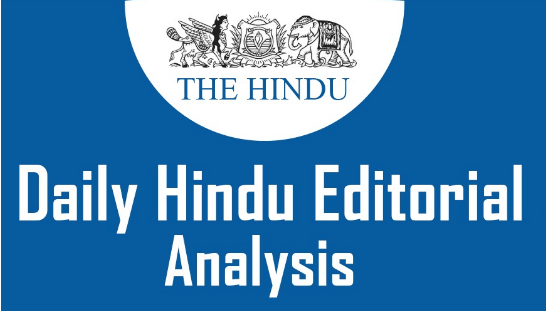
1. FAIR AND UNFAIR: ON ACTOR SURIYA AND CONTEMPT-
GS 2- Important aspects of governance, transparency and accountability
Context
It is a matter of relief that the Madras High Court has decided not to pursue(follow) the ill-conceived attempt to initiate action against film actor Suriya for contempt of court.
Contempt of Court
Contempt is nothing but lowering down prestige of the court. Basically essence of respect towards court is the objective behind contempt of courts act. Contempt is defined under section 2 of the Contempt of Courts Act 1971.
Unwarranted Petition
(i) In a detailed order, the Court has rightly noted that “it is not the job of a constitutional court to use a sledgehammer(power) for issues that do not deserve contempt.
(ii) In the course of a statement against the National Eligibility-cum-Entrance Test (NEET) for medical admissions in the country, the actor had indirectly questioned the propriety(wisdom) of the Supreme Court.
(iii) SC allowed NEET to be held across the country during the pandemic when the Court itself was holding virtual hearings out of fear of infection.
(iv) A judge of the High Court had sought to construe(interpret) the remark as an adverse(bad) comment on the judiciary in general and one questioning the devotion and integrity of judges.
(v) The observation might have been unwarranted, but it was quite clear from the beginning that it constituted no contempt.
(vi) It did nothing more than raise the question whether Courts that went virtual in the interest of the safety of judges, lawyers, staff and litigants(lawsuit), could afford to risk the health of thousands of students.
(vii) Fortunately, the Advocate-General, Vijay Narayan, whose opinion was sought by the Chief Justice of the High Court, Amreshwar Pratap Sahi, declined consent for initiation of criminal contempt proceedings.
(viii) Agreeing with his opinion, a Bench headed by the Chief Justice, decided not to pursue the matter further.
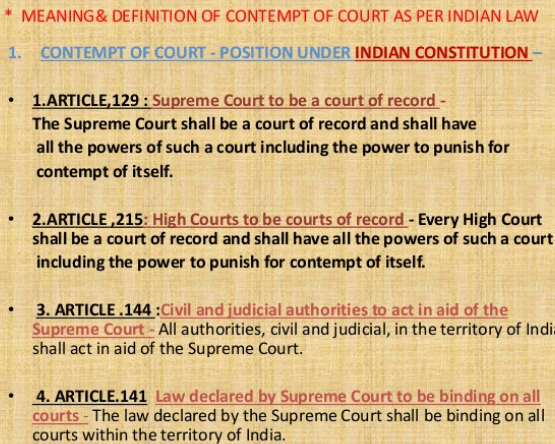
Restraint
(i) However, the Court’s 29-page order is not an unmixed blessing.
(ii) It lays much emphasis on the idea that criticism about the judiciary should be restrained(controlled), lest(else) the line of fair comment be crossed.
(iii) There is a lengthy section on the need for prudence(caution) and restraint on exuberance(cheerfulness), but such observations would be relevant and apposite only if made in the context of a strident(unpleasant) attack on the judiciary.
(iv) Did the actor’s statement contain such unbridled(unrecognized) criticism?
(v) There is no effort to parse(resolve) the offending sentence to see if there was any adverse comment on judges in general, or any aspersions(attack) cast on the system of virtual courts.
(vi) If only the Court had seen it as a comment limited to orders of the Supreme Court, it could have dropped the issue for lack of jurisdiction, as laid down by the apex court in Vitusah Oberoi (2017).
(vii) In fact, the order itself notes that no court in Tamil Nadu has dealt with the NEET issue.
(viii) While the advice for restraint is, without doubt, reasonable and well-articulated, its elaborate delineation(describe) should not open up the possibility of more such demands for contempt action in the name of deterring(discorage) unfair criticism.
(ix) As long as there is no effort to obstruct the course of justice, criticism, whether fair or unfair, does not warrant initiation of contempt proceedings.
Conclusion
Madras High Court’s advice on restraint in criticism should not allow for frivolous(not important) efforts to invoke(use) contempt.
2. IT’S A NO GREEN SIGNAL FROM THE FARM WORLD-
GS 2- Government policies and interventions for development in various sectors and issues arising out of their design and implementation
Context
(i) In a virtual rally, the PM blamed the Opposition parties for misleading farmers about the three Bills on agriculture, in Parliament.
(ii) While the Opposition may have taken up the cudgels(stick) recently, the fact is that farmers have been protesting against the Bills ever since it was promulgated(pubicized) as ordinances(temporary law) in June.
(iii) These are The Farmers' Produce Trade and Commerce (Promotion and Facilitation) Bill, 2020, the Farmers (Empowerment and Protection) Agreement of Price Assurance and Farm Services Bill, 2020, and the Essential Commodities (Amendment) Bill, 2020.
(iv) Food Processing Industries Minister (and Shiromani Akali Dal MP), Harsimrat Kaur Badal, resigned from the Union Cabinet as a sign of protest.
(v) Dissenting(not agreeing) voices from various mass organisations affiliated to the Rashtriya Swayamsevak Sangh suggest that the opposition to the Bills may not be politically motivated; rather, it may be a reflection of the genuine concerns of farmers.
(vi) In brief, the Bills aim to do away with government interference in agricultural trade.
(vii) The Bill creates trading areas free of middlemen and government taxes outside the structure of Agricultural Produce Market Committees along with removing restrictions of private stockholding of agricultural produce.
(viii) Attempts to reform the APMC are not new and have been part of the agenda of successive governments for the last two decades.
(ix) Most farmer organisations also agree that there is excessive political interference and there is need for reform as far as functioning of mandis are concerned.
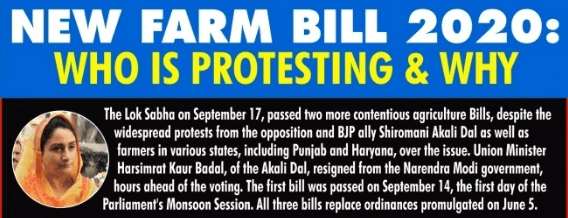
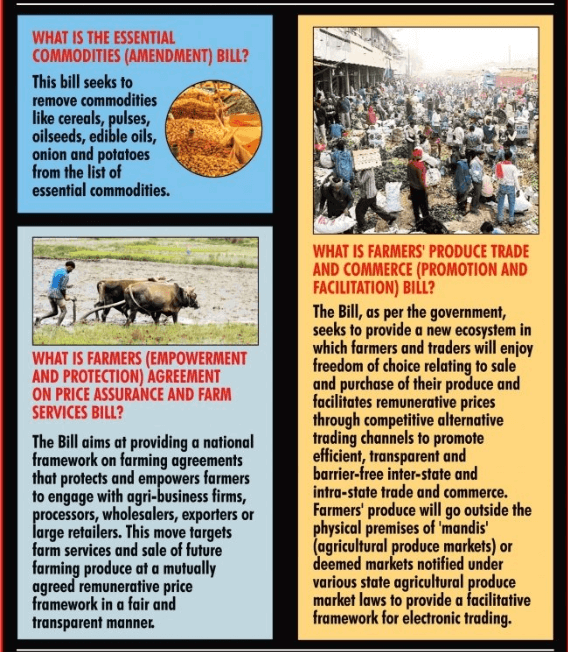
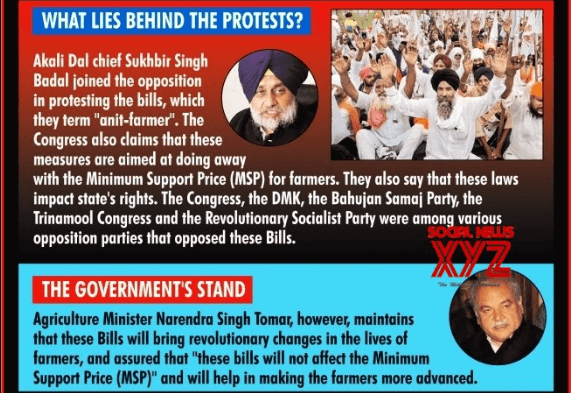
No Consultation
(i) Several reforms at the level of the central government as well as at the State level have been introduced and welcomed by farmers.
(ii) However, in this particular case, the issue is not about the Bills; it is also about the process of their introduction.
(iii) As was pointed out by Ms. Badal, the government has failed to have or hold any discussion with the various stakeholders including farmers and middlemen.
(iv) This is also true when it comes to consultation with State governments even though the subject of trade and agriculture are part of subjects on the State list.
(v) The attempt to pass the Bills without proper consultation adds to the mistrust among various stakeholders including State governments.
(vi) While the lack of consultation has certainly added to the element of mistrust between the government and farmers, some of the issues raised by farmer organisations are also genuine.
(vii) Recent trends in agricultural prices and incomes have only confirmed these fears.
(viii) While farmer organisations see these Bills as part of the larger agenda of corporatisation of agriculture and a withdrawal of government support, the immediate concern has been the attempt to weaken the APMC mandis and eventual withdrawal of the MSP guaranteed by the government.
(ix) Although the government has clarified that these Bills do not imply withdrawal of procurement by the State at MSP, there is a genuine fear among farmers about the true intentions of the government.
(x) The mistrust is not unfounded given the track record of this government on many issues including demonetisation of 2016, the introduction of Goods and Services Tax and so on.
(xi) There may not be direct evidence of crony(friendly) capitalism, but the entry, in a big way, of two of the biggest corporate groups (Adani and Reliance) in food and agricultural retail and the timing of the Bills have not gone unnoticed.
Reflects Poor Understanding
(i) The idea of allowing greater participation of traders and farmers outside the APMC has already been in place in different form.
(ii) Even otherwise, APMCs account for less than a fourth of total agricultural trade.
(iii) But APMCs do play an important role of price discovery essential for agricultural trade and production choices.
(iv) The vilification(defaming) of APMCs and the middlemen who facilitate trade in these mandis is a poor reflection of the understanding of functioning of agricultural markets.
(v) The middlemen are a part of the larger ecosystem of agricultural trade, with deep links between farmers and traders.
(vi) Most farmers are familiar with the functioning of mandis and see it as an essential part of agricultural trade despite shortcomings.
(vii) While the proposed Bills do not do away with the APMC mandis, the preference for corporate interests at the cost of farmers’ interests and a lack of regulation in these non-APMC mandis are cause for concern.
(viii) The absence of any regulation in non-APMC mandis is being seen as a precursor(forerunner) to the withdrawal of the guarantee of MSP-based procurement.
The Bihar Example
(i) The dominant concern in this regard has been expressed by farmers in Punjab and Haryana.
(ii) Farmers in these States have genuine concern about the continuance of the MSP-based public procurement given the large-scale procurement operations in these States.
(iii) These fears gain strength with the experience of States such as Bihar which abolished(ended) APMCs in 2006.
(iv) After the abolition of mandis, farmers in Bihar on average received lower prices compared to the MSP for most crops.
(v) For example, as against the MSP of ₹1,850 a quintal for maize, most farmers in Bihar reported selling their produce at less than ₹1,000 a quintal.
(vi) Despite the shortcomings and regional variations, farmers still see the APMC mandis as essential to ensuring the survival of MSP regime.
Conclusion
(i) While retail prices have remained high, data from the Wholesale Price Index (WPI) suggest a deceleration in farm gate prices for most agricultural produce.
(ii) This has happened despite increased procurement through the MSP-based regime for paddy and wheat.
(iii) Decline in basmati rice prices by more than 30% and despite higher international prices suggests the limitation of market intervention in raising farm gate prices.
(iv) For most crops where MSP-led procurement is non-existent, the decline has been sharper.
(v) Even cash crops such as cotton have seen a collapse in prices in the absence of government intervention.
(vi) With rising input costs, farmers do not see the market providing them remunerative prices.
(vii) At the same time, ad hoc(temporary) interventions by government such as raising import duties on masur and a ban on onion exports also raise suspicion about the intent of the government to leave the price discovery mechanism on the market.
(viii) The protests by farmers are essentially a reflection of the mistrust between farmers and the stated objective of these reforms.
3. GREAT POWER, LITTLE RESPONSIBILITY-
GS 2- Important International institutions, agencies and fora, their structure, mandate
Context
(i) The International Day of Peace (September 21) is an occasion for deep reflection about the prevalence(presence) of war, violence and insecurity in many parts of the world.
(ii) In the last calendar year, eight countries — Afghanistan, Yemen, Syria, Turkey, Somalia, Iraq, Mexico and Libya — suffered at least 1,000 deaths each (mainly civilians) through militarised attacks and battles, according to the World Population Review.
(iii) If one includes the Maghreb and Sahel regions of North and West Africa, over 25 countries are being ravaged(destructed) by deadly wars today.
(iv) 79.5 million were displaced at the end of 2019, due to armed conflicts, persecution(suffering) and other reasons, according to the UN Refugee Agency.
(v) The way the present international system is structured poses enormous(huge) obstacles to peace.
(vi) The countries that are escalating(raising) violence are predominantly the great powers who have military and economic might.

Fuelling Instability
(i) On paper, the U.S., Russia and China uphold peace and stability as the permanent members of the UN Security Council.
(ii) But in practice, they fuel(create) instability and are involved in most ongoing wars.
(iii) For example, the tragedy in Yemen, which the UN has declared as the world’s worst humanitarian disaster.
(iv) Disaster was the outcome of indiscriminate attacks by the U.S.-backed coalition of Saudi Arabia and the UAE, whose geopolitical goal is to counterbalance Iran.
(v) Yet, undaunted(unafraid) by the moral burden, the Donald Trump administration is eagerly selling lethal weapons to its Gulf allies in the name of their ‘security’.
(vi) War is at once a geopolitical game and big business. This holds true not only for the U.S. but also Russia.
(vii) Libya’s descent into chaos(disturbance) is the product of the active involvement of mercenaries and weapons pumped in by Russia and the U.S.-allied Gulf Arab monarchies to push back Turkey’s influence.
(viii) Like the calamity in Syria, Yemen and Libya are victims of the conduct of great powers who arm and finance regional actors to prey upon weak states for counterbalancing rivals and sustaining profits of their military industrial complexes.
China Joining The Race
(i) Not to be left behind the U.S. and Russia, China has catapulted(risen) into the ranks of top sellers of weapons.
(ii) Chinese small arms enable ethnic violence and extreme human rights abuses from South Sudan and the Democratic Republic of Congo to Pakistan and Myanmar.
(iii) China also aims to tighten its grip over developing countries through ‘internal security’ aid, a code for technological tools of domestic surveillance and repression, which in turn build up societal pressure and armed revolts against authoritarian regimes.
(iv) Moreover, China’s own hegemonic(dominant) expansionism against its neighbours and its ‘new Cold War’ with the U.S. have significantly raised risks of military clashes in Asia.
(v) This year, the UN Secretary General is campaigning for a “global ceasefire” so that everyone’s attention shifts to fighting the COVID-19 pandemic.
(vi) The UN as well as regional organisations like the African Union and the European Union are trying to negotiate cessation(ending) of hostilities(aggression) in various war zones.
Conclusion
(i) But targeted micro-level diplomatic initiatives cannot ameliorate(reduce) the underlying macro-level problem of great powers and their allies acting with brazen(sheer) impunity(exemption from punishment).
(ii) On the International Day of Peace, we should diagnose the core problem — the unjust structure which privileges great powers and permits their ghastly(horrible) machinations — and challenge it.
(iii) Altering the structure and nature of world politics is not child’s play. But we must strive for it.
(iv) Remember that if one fire is doused(extinguished) in Afghanistan through a peace process, 10 more fires can be lit as long as the global ‘system’ that reproduces violence and aggression is in place.
(v) Intellectuals, social movements and responsible states should prioritise struggling for an equitable world order. Nothing less will suffice(be sufficient) to silence the guns.
|
21 videos|562 docs|160 tests
|
FAQs on The Hindu Editorial Analysis- 21st Sept, 2020 - Additional Study Material for UPSC
| 1. What is the significance of analyzing The Hindu editorials for UPSC preparation? |  |
| 2. What are the key points to consider while analyzing an editorial for UPSC preparation? |  |
| 3. How can The Hindu editorials be integrated into the UPSC study plan effectively? |  |
| 4. What are the benefits of using The Hindu editorials for answer writing practice in UPSC exams? |  |
| 5. How can one effectively analyze The Hindu editorials to extract maximum value for UPSC preparation? |  |





















